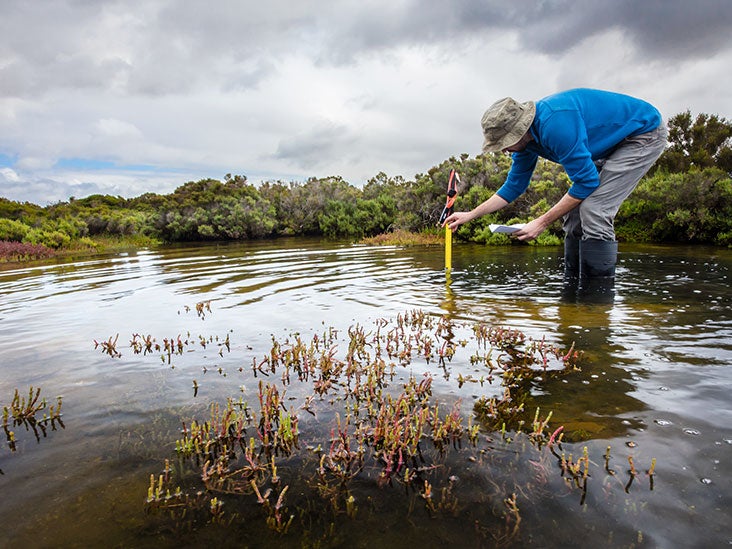What is nutria itch? Symptoms, causes, and treatment - Medical News Today

The larvae of roundworms living inside nutrias may cause a severe rash and swelling as the larvae enter the human skin. Doctors refer to this as nutria itch.
Nutrias or coypu rats are large, semi-aquatic, herbivorous rodents. They live in burrows and marshes near freshwater or brackish water areas. They are also hosts to several zoonotic diseases that parasites, bacteria, and viruses may cause.
Zoonotic diseases are infectious diseases that
According to the United States Department of Agriculture (USDA), nutrias are an invasive species in the United States. Experts define an invasive species as a species not native to the ecosystem it inhabits and causes or is likely to cause harm to the economy, environment, or human health in that ecosystem.
This article explores nutria itch, its symptoms, causes, and treatment. The article also discusses how doctors diagnose it and how a person can prevent infection.
Nutria itch is an infectious disease that
Symptoms of nutria itch may include:
Other symptoms may include:
- vesicular rash, a rash with itchy, fluid-filled blisters
- pustular rash, a rash with pus-filled blisters
- burning pain
Many people report symptoms a few hours after being in wetlands that nutrias populate. The greater the person's exposure to contaminated water and soil, the more immediate and intense the symptoms.
Nutrias make their dens near people's yards or homes, making these individuals at risk of harmful health conditions. Nutrias may host several viruses, bacteria, and parasites, including Salmonella, Toxoplasma gondii, and blood flukes.
The parasite Strongyloides myopotami is a type of microscopic roundworm that
Unlike many other burrowing animals, nutrias leave their waste anywhere. This can lead to contamination of the soil and swimming or drinking water, which transmits diseases to humans and other animals.
The parasite eggs hatch into larvae after several days. They penetrate outer clothing and rapidly bury and tunnel through a person's skin. This causes an intense inflammatory response, leading to red rashes and severe itching.
Unlike in nutria, these roundworms cannot reach the inner organs of humans. They eventually die after several weeks. While alive, these parasites continue to creep and burrow, causing the person to have severe itching and inflammation in the skin.
The symptoms of nutria itch tend to go away once the parasite larvae die. However, this may take several weeks.
There are several treatments for nutria itch. However, they vary depending on the person's response and the severity of their symptoms.
Doctors
Ivermectin and thiabendazole are deworming (anthelmintic) agents that doctors may use to treat Strongyloides infections and intestinal pinworms.
Topical medications, such as hydrocortisone creams, may also work to relieve symptoms in mild cases.
A person may help relieve itching by:
- applying cool compresses to affected areas
- bathing in Epsom salts
- having colloidal oatmeal baths
- using anti-itch lotions
- making and applying a baking soda paste to the itchy rashes
Learn other home remedies to relieve itching here.
A healthcare professional usually makes a diagnosis of nutria itch by looking at a person's skin and their recent travel history to an area where nutrias are present.
Rarely, a doctor may require a skin biopsy to rule out other conditions. They may also request a blood test to check if a person has increased eosinophils or antibodies for the Strongyloides parasite. Eosinophils are a type of white blood cell. A doctor may also require a stool sample to check for eggs or larvae.
Nutria itch is a common hazard for individuals who spend time in certain wetlands and marshes. This includes nutria trappers, fishers, hunters, and researchers.
It is important not to touch or make contact with the soil, water, mud, or marshy areas if possible. To reduce the likelihood of developing nutria itch, a person should:
- wear high boots or waders when walking in water
- prevent water from entering their boots or splashing over the top of their boots
- avoid getting their clothing wet
- avoid swimming or wading through areas where nutria itch is a known problem
- shower or towel dry immediately after leaving the water
Nutria itch is an infectious disease that causes severe rashes, skin irritation, and swelling. A person may come into contact with parasites that cause nutria itch through soil and water containing nutria waste.
While the disease is self-limiting, meaning it slows its own growth itself, medications may relieve symptoms and quicken healing. Similarly, a person may be able to relieve nutria itch symptoms using home remedies such as Epsom salts or colloidal oatmeal baths.
However, people should speak to a doctor if they believe they may have nutria itch.
Comments
Post a Comment